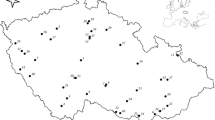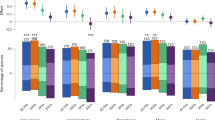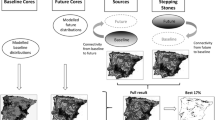Abstract
Land use change alters species' abundance and distributions by affecting habitat availability and quality. The decline of bird populations worldwide is of major concern, and habitat protection and restoration are primary conservation actions. However, conservation decisions largely consider only short-term habitat changes and species’ population dynamics in a given area. Disregarding long term modifications in species’ available habitat, and the role of a given population for a species’ global population may lead to misdirected conservation action. Our goal here was to combine the assessment of conservation responsibility, with that of century-long available habitat dynamics, in order to inform better conservation practice. We compiled available habitat data for 170 bird species in the Carpathian Region from 1860 to 2010 from historic maps and satellite data. We analyzed these species’ range distributions, IUCN extinction risk and population trends, and we identified 29 species of high conservation responsibility, and all of them were forest or and grassland specialists. Furthermore, we found major land use trends including cropland abandonment and increase in forests and grasslands that resulted in increases in potential habitat for the species for which the Carpathians have high conservation responsibility. The loss of row-crop agriculture, on the other hand, reduced habitat for species for which the Carpathians do not have high responsibility, and thus subsidizing agriculture may not be warranted from a conservation perspective. More broadly, many regions worldwide are undergoing rapid land use changes, and we suggest that these should be analyzed relative to a given regions’ conservation responsibility to see if there are opportunities for conservation, i.e., cases similar to the Carpathians, where conservation efforts ‘only’ have to foster current land use trends, and make them permanent, rather than to try to revert the loss of habitat.






Similar content being viewed by others
References
Åberg J, Swenson JE, Angelstam P (2003) The habitat requirements of hazel grouse (Bonasa bonasia) in managed boreal forest and applicability of forest stand descriptions as a tool to identify suitable patches. For Ecol Manag 175:437–444. https://doi.org/10.1016/S0378-1127(02)00144-5
Akeroyd JR, Page JN (2011) Conservation of High Nature Value (HNV) grassland in a farmed landscape in Transylvania, Romania. Contrib Bot XLVI:57–71
Alcantara C, Kuemmerle T, Baumann M et al (2013) Mapping the extent of abandoned farmland in Central and Eastern Europe using MODIS time series satellite data. Environ Res Lett 8:35035. https://doi.org/10.1088/1748-9326/8/3/035035
Balmford A, Bruner A, Cooper P et al (2002) Economic reasons for conserving wild nature. Science 297:950–953. https://doi.org/10.1126/science.1073947
Baumann M, Kuemmerle T, Elbakidze M et al (2011) Patterns and drivers of post-socialist farmland abandonment in Western Ukraine. Land Use Policy 28:552–562. https://doi.org/10.1016/j.landusepol.2010.11.003
Birdlife International (2016) Birdlife Data Zone. Terms and definitions. http://www.birdlife.org/datazone/info/spchabalt. Accessed 1 Jan 2016
Birdlife International (2017) European Birds of conservation concern: populations, trends and national responsibilities. BirdLife International, Cambridge. ISBN 978-1-912086-00-9
BirdLife International and NatureServe (2014) Bird species distribution maps of the world. BirdLife International, NatureServe, Cambridge, Arlington
Brudvig LA, Grman E, Habeck CW et al (2013) Strong legacy of agricultural land use on soils and understory plant communities in longleaf pine woodlands. For Ecol Manag 310:944–955. https://doi.org/10.1016/j.foreco.2013.09.053
Busche G (1994) The decline of wet-meadow birds in Schleswig-Holstein/Germany from 1950 to 1992. J fur Ornithol 135:167–177
Butsic V, Munteanu C, Griffiths P et al (2017) The impact of protected areas on forest disturbance in the Carpathian Mountains 1985-2010. Conserv Biol 31:570–580
Ceaușu S, Carver S, Verburg PH, et al (2015a) Rewilding European Landscapes. 25–46. https://doi.org/10.1007/978-3-319-12039-3
Ceaușu S, Hofmann M, Navarro LM et al (2015b) Mapping opportunities and challenges for rewilding in Europe. Conserv Biol 29:1017–1027. https://doi.org/10.1111/cobi.12533
CERI (2001) The status of the the Carpathians. The Carpathian Ecoregion Initiative, Vienna
Cremene C, Groza G, Rakosy L et al (2005) Alterations of Steppe-Like Grasslands in Eastern Europe: a threat to regional biodiversity hotspots. Conserv Biol 19:1606–1618. https://doi.org/10.1111/j.1523-1739.2005.00084.x
Demerdzhiev D, Horváth M, Kovács A et al (2011) Status and population trend of the eastern imperial eagle (Aquila heliaca) in Europe in the period 2000-2010. Acta Zool Bulg 63:5–14
Donald PF, Gree RE, Heath MF (2001) Agricultural intensification and the collapse of Europe’s farmland bird populations. Proc Biol Sci 268:25–29. https://doi.org/10.1098/rspb.2000.1325
Donald PF, Pisano G, Rayment MD, Pain DJ (2002) The common agricultural policy, EU enlargement and the conservation of Europe’s farmland birds. Agric Ecosyst Environ 89:167–182. https://doi.org/10.1016/S0167-8809(01)00244-4
Dullinger S, Essl F, Rabitsch W et al (2013) Europe’s other debt crisis caused by the long legacy of future extinctions. Proc Natl Acad Sci USA 110:7342–7347. https://doi.org/10.1073/pnas.1216303110
Elts J (1997) Studies of the Corncrake in Estonia in 1995. Vogelwelt 118:236–238
European Court of Auditors (2011) Is agri-environment support well designed and managed? Luxembourg
Figueiredo J, Pereira HM (2011) Regime shifts in a socio-ecological model of farmland abandonment. Landsc Ecol 26:737–749. https://doi.org/10.1007/s10980-011-9605-3
Fischer J, Hartel T, Kuemmerle T (2012) Conservation policy in traditional farming landscapes. Conserv Lett 5:167–175. https://doi.org/10.1111/j.1755-263X.2012.00227.x
Foley JA, DeFries RS, Asner GP, et al (2005) Global consequences of land use. Science (80-) 309:570–574. https://doi.org/10.1126/science.1111772
Gallego J, Delince´ J (2010) The European land use and cover area-frame statistical survey. In Benedetti R, Bee M, Espa G, Piersimoni F (eds) Agricultural survey methods. Wiley, New York 151–168
Green RE, Cornell SJ, Scharlemann JPW, Balmford A (2005) Farming and the fate of wild nature. Science 307:550–555. https://doi.org/10.1126/science.1106049
Gregory RD, Vorisek P, Van Strein A, et al (2007) Population trends of widespread woodland birds in Europe. Ibis (Lond 1859) 149:78–97. https://doi.org/10.1111/j.1474-919x.2007.00698.x
Griffiths P, Müller D, Kuemmerle T, Hostert P (2013) Agricultural land change in the Carpathian Ecoregion after the breakdown of socialism and expansion of the European Union. Environ Res Lett 8:45024. https://doi.org/10.1088/1748-9326/8/4/045024
Griffiths P, Kuemmerle T, Baumann M et al (2014) Forest disturbances, forest recover, and changes in forest types across the Carpathian Ecoregion from 1985 to 2010 based on Landsat image composites. Remote Sens Environ 151:72–88
Halada L, Ružičková H, David S, Halabuk A (2008) Semi-natural grasslands under impact of changing land use during last 30 years: Trollio-Cirsietum community in the Liptov region (N Slovakia). Commun Ecol 9:115–123
Hallmann B (1996) The decline of the Imperial Eagle Aquila heliaca in Greece. Eagle Stud 439–442
Hansen MC, Stehman SV, Potapov PV (2010) Quantification of global gross forest cover loss. Proc Natl Acad Sci USA 107:8650–8655. https://doi.org/10.1073/pnas.0912668107
Hartel T, Dorresteijn I, Klein C et al (2013) Wood-pastures in a traditional rural region of Eastern Europe: characteristics, management and status. Biol Conserv 166:267–275. https://doi.org/10.1016/j.biocon.2013.06.020
Hartvigsen M (2014) Land reform and land fragmentation in Central and Eastern Europe. Land Use Policy 36:330–341
Jaeger JAG, Soukup T, Madriñán LF et al (2011) Landscape fragmentation in Europe. European Environment Agency, Brussells
Jongman RHG (2002) Homogenisation and fragmentation of the European landscape: ecological consequences and solutions. Landsc Urban Plan 58:211–221. https://doi.org/10.1016/S0169-2046(01)00222-5
Kaim D, Kozak J, Kolecka N et al (2016) Broad scale forest cover reconstruction from historical topographic maps. Appl Geogr 67:39–48. https://doi.org/10.1016/j.apgeog.2015.12.003
Kajtoch Ł, Żmihorski M, Wieczorek P (2015) Habitat displacement effect between two competing owl species in fragmented forests. Popul Ecol 57:517–527. https://doi.org/10.1007/s10144-015-0497-y
Keller V, Bollman K (2004) From red list to species of conservation concern. Conserv Biol 18:1636–1644
Keller V, Bollmann K (2001) Fuer welche Vogelarten traegt die Schweiz eine besondere Verantwortung? Ornithol Beobachter 98:323–340
Knorn J, Kuemmerle T, Radeloff VC et al (2012) Continued loss of temperate old-growth forests in the Romanian Carpathians despite an increasing protected area network. Environ Conserv 40:182–193. https://doi.org/10.1017/S0376892912000355
Koleček J, Reif J, Weidinger K (2015) The abundance of a farmland specialist bird, the skylark, in three European regions with contrasting agricultural management. Agric Ecosyst Environ 212:30–37. https://doi.org/10.1016/J.AGEE.2015.06.018
Kozak J, Ostapowicz K, Byterowicz A, Wyzga B (2013a) The Carpathian mountains: challenges for the Central and Eastern European Landmark. The Carpathians: integrating nature and society towards sustainability. Springer, Berlin, pp 1–11
Kozak J, Ostapowicz K, Bytnerowicz A, Wyżga B (eds) (2013b) The Carpathians: integrating nature and society towards sustainability. Springer, Berlin Heidelberg
Kuemmerle T, Hostert P, Radeloff VC et al (2008) Cross-border comparison of post-socialist farmland abandonment in the Carpathians. Ecosystems 11:614–628
Kuemmerle T, Perzanowski K, Chaskovskyy O et al (2010) European bison habitat in the Carpathian mountains. Biol Conserv 143:908–916. https://doi.org/10.1016/j.biocon.2009.12.038
Landres PB, Morgan P, Swanson FJ (1999) Overview of the use of natural variability concepts in managing ecological systems. Ecol Appl 9:1179–1188. https://doi.org/10.1890/1051-0761(1999)009[1179:OOTUON]2.0.CO;2
Lõhmus A (2003) Do ural owls (Strix uralensis) suffer from the lack of nest sites in managed forests? Biol Conserv 110:1–9. https://doi.org/10.1016/S0006-3207(02)00167-2
Loos J, Dorresteijn I, Hanspach J et al (2014) Low-intensity agricultural landscapes in Transylvania support high butterfly diversity: implications for conservation. PLoS ONE 9:e103256. https://doi.org/10.1371/journal.pone.0103256
Mikulcak F, Newig J, Milcu AI et al (2013) Integrating rural development and biodiversity conservation in Central Romania. Environ Conserv 40:129–137. https://doi.org/10.1017/S0376892912000392
Mikusiński G, Gromadzki M, Chylarecki P (2001) Woodpeckers as indicators of forest bird diversity. Conserv Biol 15:208–217. https://doi.org/10.1111/j.1523-1739.2001.99236.x
Munroe DK, van Berkel DB, Verburg PH, Olson JL (2013) Alternative trajectories of land abandonment: causes, consequences and research challenges. Curr Opin Environ Sustain. https://doi.org/10.1016/j.cosust.2013.06.010
Munteanu C, Kuemmerle T, Boltiziar M et al (2014) Forest and agricultural land change in the Carpathian region—a meta-analysis of long-term patterns and drivers of change. Land use policy 38:685–697. https://doi.org/10.1016/j.landusepol.2014.01.012
Munteanu C, Kuemmerle T, Keuler NS et al (2015) Legacies of 19th century land use shapes contemporary forest cover. Glob Environ Chang 34:83–94
Munteanu C, Nita M-D, Abrudan IV, Radeloff VC (2016) Historical forest management in Romania is imposing strong legacies on contemporary forests and their management. For Ecol Manag 361:179–193
Munteanu C, Kuemmerle T, Boltižiar M, et al (2017a) 19th century land-use legacies affect contemporary land abandonment in the Carpathians. Reg Environ Chang (in press)
Munteanu C, Radeloff V, Griffiths P, et al (2017b) Land change in the Carpathian Region before and after major institutional changes. In: Gutman G, Radeloff VC (eds) Land use and land cover change in Eastern Europe after the colllapse of socialism. Springer, Berlin 57–90
Navarro LM, Pereira HM (2012) Rewilding abandoned landscapes in Europe. Ecosystems 15:900–912. https://doi.org/10.1007/s10021-012-9558-7
Newbold T, Hudson LN, Hill SLL et al (2015) Global effects of land use on local terrestrial biodiversity. Nature 520:45–50. https://doi.org/10.1038/nature14324
Pereira HM, Navarro LM (eds) (2015) Rewilding European landscapes. Springer, Berlin
Plieninger T, Höchtl F, Spek T (2006) Traditional land-use and nature conservation in European rural landscapes. Environ Sci Policy 9:317–321. https://doi.org/10.1016/j.envsci.2006.03.001
Plue J, Meuris S, Verheyen K, Hermy M (2009) The importance of artefacts of ancient land use on plant communities in Meerdaal forest, Belgium. Belgian J Bot 142:16
Queiroz C, Beilin R, Folke C, Lindborg R (2014) Farmland abandonment: threat or opportunity for biodiversity conservation? A global review. Front Ecol Environ 12:288–296. https://doi.org/10.1890/120348
Regos A, Domínguez J, Gil-Tena A et al (2016) Rural abandoned landscapes and bird assemblages: winners and losers in the rewilding of a marginal mountain area (NW Spain). Reg Environ Chang 16:199–211. https://doi.org/10.1007/s10113-014-0740-7
Reif J, Hanzelka J (2016) Grassland winners and arable land losers: the effects of post-totalitarian land use changes on long-term population trends of farmland birds. Agric Ecosyst Environ 232:208–217. https://doi.org/10.1016/j.agee.2016.08.007
Reif J, Voříšek P, Šťastnyˇ K et al (2007) Population increase of forest birds in the Czech Republic between 1982 and 2003. Bird Study 54:248–255. https://doi.org/10.1080/00063650709461481
Reif J, Storch D, Voříšek P et al (2008) Bird-habitat associations predict population trends in central European forest and farmland birds. Biodivers Conserv 17:3307–3319. https://doi.org/10.1007/s10531-008-9430-4
Roberge J-M, Angelstam P, Villard M-A (2008) Specialised woodpeckers and naturalness in hemiboreal forests—deriving quantitative targets for conservation planning. Biol Conserv 141:997–1012. https://doi.org/10.1016/j.biocon.2008.01.010
Salmen H (1980) Die Ornis Siebenbuergerns. Bohlau Verlag, Beitraege zu einer Monographie der Vogelwelt dieses Landes
Schaublin S, Bollmann K (2011) Winter habitat selection and conservation of Hazel Grouse (Bonasa bonasia) in mountain forests. J Ornithol 152:179–192. https://doi.org/10.1007/s10336-010-0563-3
Schmeller DS, Gruber B, Budrys E et al (2008) National responsibilities in European species conservation: a methodological review. Conserv Biol 22:593–601. https://doi.org/10.1111/j.1523-1739.2008.00961.x
Schmeller DS, Maier A, Evans D, Henle K (2012) National responsibilities for conserving habitats—a freely scalable method. Nat Conserv 3:21–44. https://doi.org/10.3897/natureconservation.3.3710
Schmeller DS, Evans D, Lin YP, Henle K (2014) The national responsibility approach to setting conservation priorities-Recommendations for its use. J Nat Conserv 22:349–357. https://doi.org/10.1016/j.jnc.2014.03.002
Schmitt T, Rákosy L (2007) Changes of traditional agrarian landscapes and their conservation implications: a case study of butterflies in Romania. Divers Distrib 13:855–862. https://doi.org/10.1111/j.1472-4642.2007.00347.x
Schulte LA, Pidgeon AM, Mladenoff DJ (2005) One hundred fifty years of change in forest bird breeding habitat: estimates of species distributions. Conserv Biol 19:1944–1956. https://doi.org/10.1111/j.1523-1739.2005.00254.x
Skorka P, Lenda M, Tryjanowski P (2010) Invasive alien goldenrods negatively affect grassland bird communities in Eastern Europe. Biol Conserv 143:856–861. https://doi.org/10.1016/j.biocon.2009.12.030
Sullivan MJP, Newson SE, Pearce-Higgins JW (2015) Using habitat-specific population trends to evaluate the consistency of the effect of species traits on bird population change. Biol Conserv 192:343–352. https://doi.org/10.1016/j.biocon.2015.10.009
Swanson F, Jones J, Wallin DO, Cissel J (1994) Natural variability—implications for ecosystem management. In: Jensen M, Bourgeron P (eds) Volume II: ecosystem management: principles and applications, General Technical Report PNW-GTR 318. pp 80–94
Vera F (2010) The shifting baseline syndrome in restoration ecology. In: Hall M (ed) Restoration and history: the search for a usable environmental past. Routledge, New York, pp 98–110
Verhulst J, Baldi A, Kleijn D (2004) Relationship between land-use intensity and species richness and abundance of birds in Hungary. Agric Ecosyst Environ 104:465–473. https://doi.org/10.1016/j.agee.2004.01.043
Wade ASI, Barov B, Burfield IJ et al (2013) Quantifying the detrimental impacts of land-use and management change on european forest bird populations. PLoS ONE. https://doi.org/10.1371/journal.pone.0064552
Acknowledgements
We are most grateful to all partners and student collaborators who helped digitize the historic land use maps. We thank J. Koleček and two anonymous reviewers for their valuable comments on an earlier version of the manuscript. We gratefully acknowledge support by the Land-Cover and Land-Use Change Program of the National Aeronautic Space Administration (NASA) and the NASA Earth System Science Fellowship Program (NESSF).
Author information
Authors and Affiliations
Corresponding author
Additional information
Communicated by David Hawksworth.
Electronic supplementary material
Below is the link to the electronic supplementary material.
Rights and permissions
About this article
Cite this article
Munteanu, C., Pidgeon, A.M. & Radeloff, V.C. Bird conservation in the Carpathian Ecoregion in light of long-term land use trends and conservation responsibility. Biodivers Conserv 27, 2051–2068 (2018). https://doi.org/10.1007/s10531-018-1524-z
Received:
Revised:
Accepted:
Published:
Issue Date:
DOI: https://doi.org/10.1007/s10531-018-1524-z




